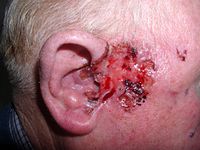
Photo from wikipedia
Micro‐Abstract From 2010 to 2015, we treated 10 patients affected by carcinoma in situ of the glans penis with topical imiquimod followed by carbon dioxide laser ablation. Histologic examination showed… Click to show full abstract
Micro‐Abstract From 2010 to 2015, we treated 10 patients affected by carcinoma in situ of the glans penis with topical imiquimod followed by carbon dioxide laser ablation. Histologic examination showed a complete response in 6 patients with human papillomavirus‐related lesions, no change in 2 patients, and progressive disease in 2 patients. Caution and close follow‐up are mandatory if glans penis carcinoma in situ is treated using topical imiquimod, even if this drug seems to be effective in human papillomavirus‐related lesions. Background: Different approaches have been described in published studies for carcinoma in situ (CIS) of the glans penis (erythroplasia of Queyrat), including topical chemotherapy or immunotherapy and laser or surgical excision. We evaluated the efficacy of topical imiquimod (IQ) followed by carbon dioxide laser ablation of the lesion. Patients and Methods: From 2010 to 2015, 10 patients affected by CIS of the glans were treated by IQ, followed by carbon dioxide laser ablation. For every patient, we performed histologic examination before and after IQ. Local toxicity and adverse effects were recorded. Results: After treatment, histologic examination showed no residual tumor in 6 patients (complete response [CR]), stable disease in 2 patients, and progressive disease in 2 patients. Those with a CR had human papillomavirus‐related lesions, and they had no experienced relapses after a mean follow‐up of 26 months. The 2 patients with progressive disease underwent total penectomy. All patients were alive at the last follow‐up examination. All patients experienced a mild local toxicity (burning erythema) but no major adverse effects. Conclusion: Local treatment with IQ for glans CIS is effective mainly for human papillomavirus‐related lesions. The present study is the first to record the histologic examination findings before and after IQ treatment. The small number of patients, owing to the rarity of this disease, was the main limitation of the present study. IQ must be used carefully, and a close follow‐up protocol is mandatory because of the lack of long‐term efficacy data.
Journal Title: Clinical Genitourinary Cancer
Year Published: 2017
Link to full text (if available)
Share on Social Media: Sign Up to like & get
recommendations!